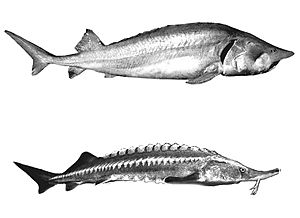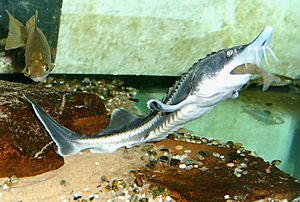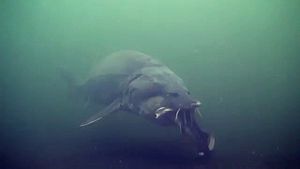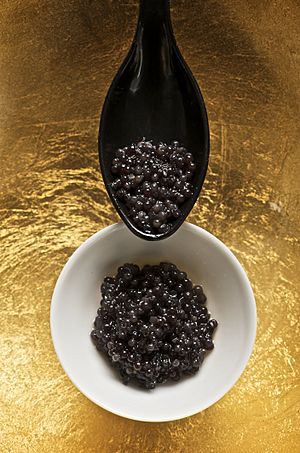Beluga (sturgeon) facts for kids
Quick facts for kids BelugaTemporal range: Pleistocene-recent
|
|
|---|---|
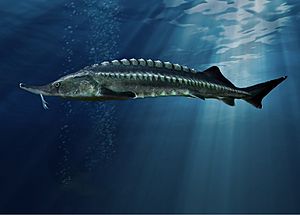 |
|
| Huso huso | |
| Conservation status | |
| Scientific classification | |
| Genus: |
Huso
|
| Species: |
huso
|
The beluga sturgeon (Huso huso) is a very large type of fish in the sturgeon family. It is also known as the great sturgeon. This amazing fish lives mostly in the Caspian and Black Sea areas. It used to live in the Adriatic Sea too.
The beluga sturgeon is one of the biggest bony fish alive today. People have hunted it a lot for its valuable eggs, called beluga caviar. This has caused its numbers in the wild to drop greatly.
Contents
What's in a Name?
The name "beluga" comes from the Russian word belyj, which means "white". This probably refers to the pale, whitish color on the sides and belly of the beluga sturgeon. Other sturgeons are usually darker.
Meet the Beluga Sturgeon
The beluga sturgeon looks like a typical sturgeon. It has a long body and a tail that is uneven, like a shark's. Its skeleton is partly made of soft material called cartilage. Its skin is smooth, not scaly, and has rows of bony plates called scutes.
Beluga sturgeons change a lot as they grow:
- Young belugas are thin. Their head is narrow, and their mouth is on the bottom but points up. Their snout is thin and pointy. Their bony plates (scutes) are easy to see. Their back and sides are dark gray or black, and their belly is white.
- Adult belugas are heavy and shaped like a spindle. Very large ones can have a hump on their back. Their head is big, and their mouth is huge and can stick out. As they get older, their mouth moves more towards the front of their head. Their snout becomes shorter. The bony plates on their skin slowly disappear. Their color is blue-gray or dark brown with silver or gray sides and a white belly. Their dark back stands out against the rest of their body.
- Very old belugas are very thick and strong. They have an impressive head and a giant mouth.
How Big Can They Get?
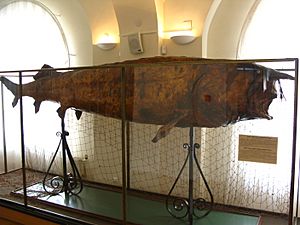
The beluga sturgeon is one of the most massive bony fish in the world. It can be as heavy as the ocean sunfish. It is also the second longest fish after the giant oarfish. It is known as the largest freshwater fish. The beluga sturgeon also competes with the great white shark for the title of largest active hunting fish.
The biggest beluga ever recorded was a female caught in 1827. It weighed about 1,571 kg (3,463 lb) and was 7.2 meters (23.6 feet) long! Another one reportedly weighed 1,220 kg (2,690 lb) and was 6.1 meters (20 feet) long. Some old sturgeons have been over 5 meters (16.4 feet) long. Only the Kaluga sturgeon, which is a close relative, can reach a similar size.
Belugas that are this huge are very old. They keep growing throughout their lives. Sadly, these giant belugas are now very rare. This is because people have fished them too much. Today, most adult belugas caught are usually 142 to 328 cm (4.7 to 10.8 feet) long. They weigh between 19 and 264 kg (42 to 582 lb). Female belugas are usually about 20% larger than males.
Beluga Life Cycle
Spawning Journey
Like many sturgeons, the beluga is an anadromous fish. This means it lives in the sea but travels up rivers to lay its eggs. They lay their eggs on clean, hard riverbeds. These spots help protect their sticky eggs.
Sturgeons have lived in the Danube River for a very long time. They have adapted to its changing valley. This is why some belugas travel very far upstream to lay eggs, while others lay them closer to the sea. To make these long journeys, sturgeons often enter the river in the fall. They then spend the winter resting in parts of the river with good water flow. Today, there are very few known places where sturgeons can rest and lay eggs in the Danube River.
Male belugas become ready to reproduce at 12 to 16 years old. Females are ready later, at 16 to 22 years old. Both males and females will lay eggs every 4 to 7 years. In the past, beluga sturgeons could travel up to 1,000 km (620 miles) upriver to lay eggs. But now, dams block almost all the major rivers they used to use.
The female lays her eggs on gravel, usually 4 to 40 meters (13 to 130 feet) underwater. When the eggs hatch, the baby fish are about 11 to 14 mm (0.4 to 0.5 inches) long. After 10 to 14 days, they absorb their yolk sac and grow to 18 to 20 mm (0.7 to 0.8 inches). Young belugas usually eat small creatures that live on the river bottom. But once they reach about 10 cm (4 inches) long, they start eating other fish. As they swim back to the ocean, young sturgeons can travel up to 60 km (37 miles) a day!
What Do Belugas Eat?
The beluga sturgeon is a predator that hunts in open water. This is different from most sturgeons, which stay closer to the bottom. When a beluga catches prey, it sucks it into its mouth very quickly.
Young belugas eat small invertebrates (animals without backbones) in rivers and shallow coastal waters. They grow fast! Once they are 8 to 10 cm (3 to 4 inches) long, they mostly eat fish.
Adult belugas eat many different kinds of large fish. Fish make up about 73% of their diet. They might also eat mollusks (like snails or clams), crustaceans (like crabs), water birds, and even young seals, like the Caspian seal.
The types of fish belugas eat change as they get older:
- In the Caspian Sea, young belugas (smaller than 40 cm or 16 inches) mainly eat small fish called Clupeonella.
- Belugas between 40 and 280 cm (16 to 110 inches) eat different types of gobies.
- The biggest belugas eat mullets, Alosa species, and even other sturgeons.
In the salty waters of the Ponto-Caspian area, belugas prefer to eat fish like Alosa, Aspius, and Engraulis. In the rivers and estuaries of the same area, belugas that are migrating to lay eggs eat various carp-like fish. This includes common carp and roach, as well as zander and other sturgeons like the sterlet.
Not much is known about the diet of belugas from the Adriatic Sea. However, it has been reported that adult belugas there mainly ate mollusks (like cuttlefish and squid) and fish. These fish included cod, flounder, gobies, herring, mackerel, and mullets. They also ate large crustaceans. In rivers, they mostly ate local carp-like fish.
Beluga Uses
Beluga caviar is considered a very special and expensive food around the world. The meat of the beluga sturgeon is also eaten. It is a hearty white meat, similar to swordfish. Beluga caviar has always been rare and costly. Its endangered status has made it even more expensive.
The beluga's air bladder is also used to make something called isinglass. This is a clear substance used in some foods and drinks.
Protecting the Beluga
The IUCN says the beluga sturgeon is a critically endangered species. This means it is at a very high risk of disappearing from the wild. It is a protected species under the Bern Convention, which aims to conserve wildlife. Its trade is also limited by CITES, an international agreement to control trade in endangered species. In the Mediterranean Sea, the beluga population is strongly protected. It is against the law to intentionally kill these fish.
The United States Fish and Wildlife Service stopped importing beluga caviar and other beluga products from the Caspian Sea in 2005. This happened after the beluga sturgeon was listed under the U.S. Endangered Species Act.
In 2016, a place called Sturgeon Aquafarms in Florida became the first and only facility in the world to get a special permit. This permit allows them to trade in beluga sturgeon and its caviar in the USA. Since 2017, Sturgeon Aquafarms has helped efforts to bring beluga sturgeons back. They have provided over 160,000 fertilized beluga eggs to the Caspian Sea region.
See also
In Spanish: Esturión beluga para niños



